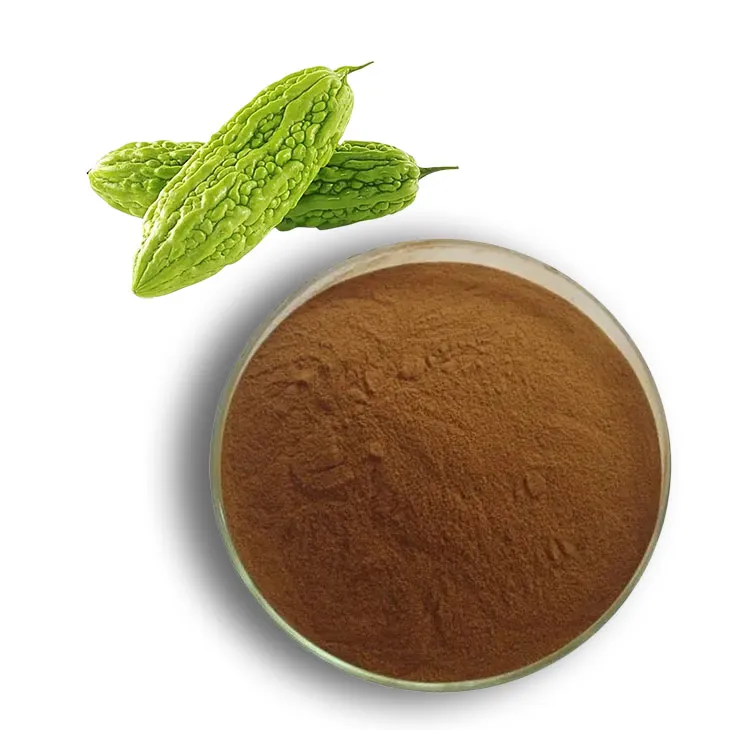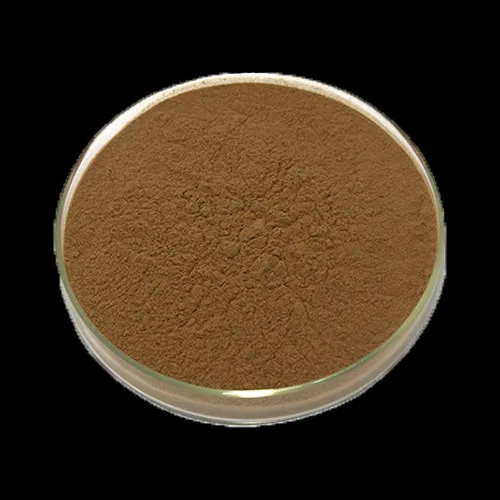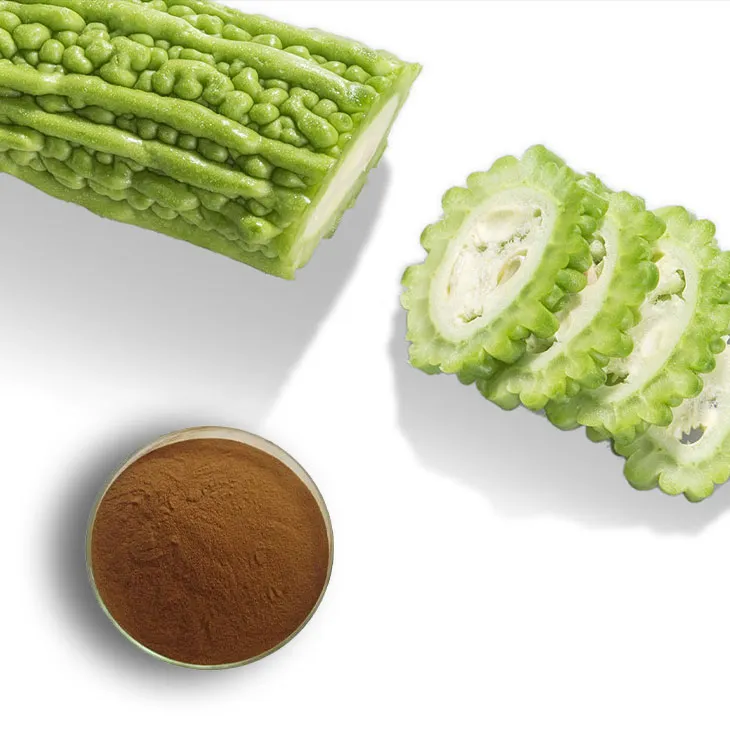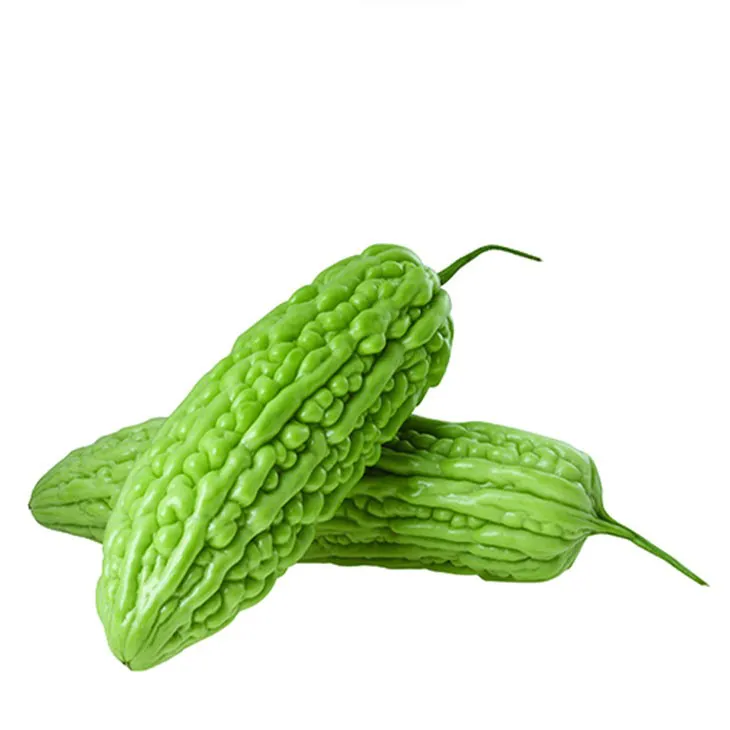- 0086-571-85302990
- sales@greenskybio.com
Extraction Technology and Production Process of Bitter Melon Extract.
2024-11-29

1. Introduction
Bitter melon (Momordica charantia) has been widely recognized for its numerous health - beneficial properties. Bitter Melon Extract is thus of great interest in various fields, including medicine, cosmetics, and food supplements. The extraction technology and production process play crucial roles in obtaining high - quality Bitter Melon Extract with desirable properties. This article aims to provide a comprehensive overview of these aspects.

2. Extraction Technologies
2.1 Enzymatic Extraction
Enzymatic extraction is a promising method for obtaining Bitter Melon Extract. This process involves the use of specific enzymes to break down the cell walls of bitter melon tissues, facilitating the release of bioactive compounds.
- Enzyme Selection: Different enzymes can be used depending on the target compounds. For example, cellulases are often employed as they can effectively degrade the cellulose in the cell walls. Pectinases may also be used in combination to break down pectin, another major component of plant cell walls.
- Process Parameters: The reaction conditions need to be carefully controlled. Temperature, pH, and enzyme concentration are critical factors. Typically, the optimal temperature for enzymatic extraction of bitter melon may range from 40 - 50°C, and the pH may be around 4.5 - 6.0. The enzyme concentration should be adjusted according to the amount of raw material and the desired extraction efficiency.
- Advantages: Compared to traditional extraction methods, enzymatic extraction can be more selective, resulting in a higher yield of specific bioactive compounds. It also generally operates under milder conditions, which can help preserve the integrity and activity of the extracted compounds. For instance, some heat - sensitive compounds in bitter melon, such as certain antioxidants, can be better retained using enzymatic extraction.
- Limitations: However, enzymatic extraction also has some drawbacks. Enzymes can be expensive, and the extraction process may be relatively time - consuming. Additionally, the presence of enzyme residues in the final extract needs to be carefully monitored and removed to ensure the safety and quality of the product.
2.2 Microwave - Assisted Extraction
Microwave - assisted extraction (MAE) is another efficient technique for bitter melon extract production.
- Principle: Microwaves can penetrate the bitter melon material and cause rapid heating through dielectric heating. This leads to an increase in the internal temperature and pressure within the plant cells, which in turn ruptures the cell walls and promotes the release of bioactive substances into the extraction solvent.
- Operating Conditions: The power and time of microwave irradiation are important parameters. For bitter melon extraction, a microwave power of 300 - 600 W and an extraction time of 5 - 15 minutes are commonly used. The choice of solvent also plays a role. Solvents with appropriate dielectric properties, such as ethanol - water mixtures, are often preferred.
- Benefits: MAE offers several advantages. It is a relatively fast extraction method, which can significantly reduce the extraction time compared to conventional methods. It can also enhance the extraction efficiency, leading to a higher yield of bioactive compounds. For example, studies have shown that MAE can increase the extraction yield of certain bitter melon alkaloids.
- Challenges: On the other hand, MAE requires specialized equipment, which may involve higher initial investment costs. There is also a need to carefully control the microwave parameters to avoid over - extraction or degradation of the target compounds. Moreover, the potential formation of hot spots during microwave irradiation may cause local overheating and affect the quality of the extract.
2.3 Solvent Extraction
Solvent extraction is a traditional and widely used method for obtaining bitter melon extract.
- Solvent Selection: Different solvents can be used based on the solubility of the target compounds. Ethanol, methanol, and water are common solvents for bitter melon extraction. Ethanol - water mixtures are often preferred as they can dissolve a wide range of bioactive compounds in bitter melon while also being relatively safe and easy to handle. For example, polar compounds such as flavonoids and saponins in bitter melon can be effectively extracted using ethanol - water solvents.
- Extraction Procedure: The extraction process typically involves soaking the bitter melon material in the solvent for a certain period of time, followed by filtration to separate the extract from the solid residue. The extraction time can range from several hours to days, depending on the nature of the compounds and the extraction conditions. The solid - to - solvent ratio also affects the extraction efficiency. A common ratio is 1:5 - 1:10 (w/v).
- Advantages: Solvent extraction is relatively simple and does not require complex equipment. It can be easily scaled up for large - scale production. Additionally, it can be used to extract a variety of compounds from bitter melon.
- Disadvantages: However, solvent extraction may have some limitations. It may be less selective compared to enzymatic or microwave - assisted extraction, resulting in a more complex extract containing a mixture of compounds. The use of organic solvents also poses potential safety and environmental concerns, such as solvent toxicity and the need for proper solvent disposal.

3. Production Process
3.1 Raw Material Preparation
The quality of raw materials is the foundation for producing high - quality bitter melon extract.
- Harvesting: Bitter melons should be harvested at the appropriate maturity stage. For most applications, mature but not over - ripe bitter melons are preferred as they contain higher levels of bioactive compounds. The harvesting time can affect the composition and quality of the extract. For example, if harvested too early, the content of certain active ingredients may be insufficient.
- Cleaning: After harvesting, bitter melons need to be thoroughly cleaned to remove dirt, pesticides, and other contaminants. This can be achieved through washing with clean water or using mild detergents in some cases. Any remaining contaminants can affect the safety and quality of the extract.
- Drying: Drying is an important step in raw material preparation. It can be carried out using natural drying or artificial drying methods. Natural drying may take longer but is more environmentally friendly. Artificial drying, such as using a dehydrator or an oven, can be faster but requires careful control of temperature and humidity to avoid over - drying or degradation of the bioactive compounds. Dried bitter melon can be stored for longer periods and is more suitable for extraction processes.
3.2 Extraction
Once the raw materials are prepared, the extraction process can be carried out using one of the methods described above, such as enzymatic extraction, microwave - assisted extraction, or solvent extraction. During the extraction process, it is crucial to:
- Monitor and Control the Process Parameters: For example, in enzymatic extraction, the temperature, pH, and enzyme concentration need to be constantly monitored and adjusted to ensure optimal extraction conditions. In microwave - assisted extraction, the power and time of microwave irradiation should be carefully controlled to prevent over - extraction or degradation of the compounds.
- Ensure Good Mixing: Adequate mixing of the raw material and the extraction solvent is necessary to ensure efficient contact between them. This can be achieved through mechanical stirring or other agitation methods. Good mixing can enhance the extraction efficiency and ensure the uniformity of the extract.
3.3 Filtration and Separation
After extraction, the resulting mixture needs to be filtered to separate the extract from the solid residues.
- Filtration Methods: There are various filtration methods available, such as vacuum filtration, pressure filtration, and membrane filtration. Vacuum filtration is commonly used for its simplicity and relatively low cost. Pressure filtration can be faster and more efficient, especially for larger - scale production. Membrane filtration can be used to further purify the extract by removing particles of a specific size.
- Separation of Impurities: In addition to removing the solid residues, the filtration process also helps to separate other impurities, such as insoluble substances and enzyme residues (in the case of enzymatic extraction). This step is crucial for ensuring the purity and quality of the extract.
3.4 Concentration and Drying
The final steps in the production process involve concentration and drying of the extract.
- Concentration: The extracted solution may contain a large amount of solvent, which needs to be removed to obtain a more concentrated extract. This can be achieved through evaporation under reduced pressure or other concentration methods. Concentration not only reduces the volume of the extract but also increases the concentration of the bioactive compounds, which is beneficial for further processing and product formulation.
- Drying: Drying is carried out to obtain a dry powder form of the extract. Spray drying and freeze - drying are two common drying methods. Spray drying is a fast and cost - effective method, suitable for large - scale production. However, it may cause some loss of volatile compounds. Freeze - drying can better preserve the structure and activity of the bioactive compounds but is more expensive and time - consuming.

4. Ensuring Safety and Stability of the Extract
Safety and stability are of utmost importance for bitter melon extract products.
- Quality Control: Rigorous quality control measures should be implemented throughout the production process. This includes testing the raw materials for contaminants, monitoring the extraction process parameters, and analyzing the final extract for its composition and purity. For example, high - performance liquid chromatography (HPLC) can be used to analyze the content of bioactive compounds in the extract.
- Stabilization Additives: To ensure the stability of the extract, appropriate stabilization additives may be added. Antioxidants can be used to prevent the oxidation of bioactive compounds, especially those that are sensitive to oxidation. For example, vitamin C or tocopherols can be added to the extract to improve its stability.
- Packaging: Proper packaging is essential for protecting the extract from environmental factors such as light, moisture, and air. Dark - colored, airtight containers are often preferred. For example, amber - colored glass bottles or aluminum - foil - laminated pouches can be used to package bitter melon extract to prevent light - induced degradation and moisture absorption.

5. Economic Feasibility of the Production
The economic feasibility of bitter melon extract production is an important consideration for its commercial viability.
- Cost of Raw Materials: The cost of bitter melon as raw material can vary depending on factors such as season, location, and quality. Sourcing high - quality bitter melon at a reasonable cost is crucial for ensuring the economic feasibility of the production. For example, in some regions where bitter melon is abundantly grown, the cost of raw material may be relatively lower.
- Cost of Equipment and Technology: The cost of extraction equipment, such as microwave generators (in the case of microwave - assisted extraction) or enzyme reactors (for enzymatic extraction), can be a significant investment. However, these costs can be amortized over the long - term production volume. Additionally, the choice of technology should also consider the overall efficiency and productivity to maximize the economic return.
- Production Scale and Market Demand: The production scale should be determined based on the market demand for bitter melon extract. A larger production scale can often lead to lower unit production costs through economies of scale. However, over - production without sufficient market demand can result in inventory build - up and financial losses. Therefore, market research and demand forecasting are essential for optimizing the production scale.
6. Conclusion
In conclusion, the extraction technology and production process of bitter melon extract are complex and multi - faceted. Different extraction technologies, such as enzymatic extraction, microwave - assisted extraction, and solvent extraction, each have their own advantages and limitations. The production process involves multiple steps, including raw material preparation, extraction, filtration, concentration, and drying. Ensuring the safety and stability of the extract is crucial for product quality, while considering the economic feasibility is necessary for commercial success. With the increasing demand for natural products in various industries, further research and development in the extraction and production of bitter melon extract are expected to continue, aiming at more efficient, safe, and cost - effective production methods.
FAQ:
What are the main extraction technologies for bitter melon extract?
There are several main extraction technologies for bitter melon extract. One is enzymatic extraction. Enzymes can break down the cell walls of bitter melon more effectively, facilitating the release of active substances. Another is microwave - assisted extraction. Microwave energy can enhance the mass transfer process during extraction, which can improve the extraction efficiency and shorten the extraction time.
How can the safety of bitter melon extract be ensured during the production process?
To ensure the safety of bitter melon extract during production, strict quality control of raw materials is the first step. Only high - quality bitter melons should be selected. During the extraction process, proper extraction solvents and conditions should be used to avoid the introduction of harmful substances. In addition, strict purification and sterilization procedures are also necessary to remove impurities and microorganisms, so as to ensure the safety of the final product.
What factors need to be considered to ensure the stability of bitter melon extract?
Several factors need to be considered to ensure the stability of bitter melon extract. Firstly, the storage conditions play a crucial role. It is usually necessary to store in a cool, dry and dark place to avoid the influence of light, heat and humidity. Secondly, proper packaging materials can also help maintain the stability of the extract. For example, using light - proof and air - tight packaging. Moreover, the addition of stabilizers may be considered in some cases to prevent the degradation of active substances in the extract.
How to evaluate the economic feasibility of the overall production of bitter melon extract?
To evaluate the economic feasibility of the overall production of bitter melon extract, several aspects need to be considered. The cost of raw materials is an important factor. If the price of bitter melons fluctuates greatly, it will directly affect the production cost. The cost of extraction equipment and energy consumption during the extraction process also needs to be taken into account. In addition, the market demand and price of the final product also determine whether the production is economically feasible. If the market price is high enough to cover all production costs and generate profits, then the production is considered economically feasible.
What are the potential applications of bitter melon extract in cosmetics?
Bitter melon extract has several potential applications in cosmetics. It may have antioxidant properties, which can help prevent skin aging by scavenging free radicals. It may also have anti - inflammatory properties, which can be beneficial for treating skin inflammation. Additionally, it may contribute to skin whitening by inhibiting the production of melanin in some ways.
Related literature
- Optimization of Bitter Melon Extract Production for Medicinal Purposes"
- "The Role of Bitter Melon Extract in Cosmetic Formulations: A Review"
- "Advances in Extraction Technologies of Bitter Melon Extract"
- ▶ Hesperidin
- ▶ citrus bioflavonoids
- ▶ plant extract
- ▶ lycopene
- ▶ Diosmin
- ▶ Grape seed extract
- ▶ Sea buckthorn Juice Powder
- ▶ Beetroot powder
- ▶ Hops Extract
- ▶ Artichoke Extract
- ▶ Reishi mushroom extract
- ▶ Astaxanthin
- ▶ Green Tea Extract
- ▶ Curcumin Extract
- ▶ Horse Chestnut Extract
- ▶ Other Problems
- ▶ Boswellia Serrata Extract
- ▶ Resveratrol Extract
- ▶ Marigold Extract
- ▶ Grape Leaf Extract
- ▶ blog3
- ▶ blog4
-
D - Mannose Manufacturer
2024-11-29
-
The best organic chia seed powder.
2024-11-29
-
Grape Seed Extract
2024-11-29
-
Hesperidin
2024-11-29
-
Peppermint Extract Powder
2024-11-29
-
Chaste Berry Extract
2024-11-29
-
Beetroot juice Powder
2024-11-29
-
Stevia Extract
2024-11-29
-
Berberis aristata Extract
2024-11-29
-
Tongkat Ali Extract
2024-11-29
-
Bilberry Extract
2024-11-29
-
Hedyotis Diffusa Extract
2024-11-29





















